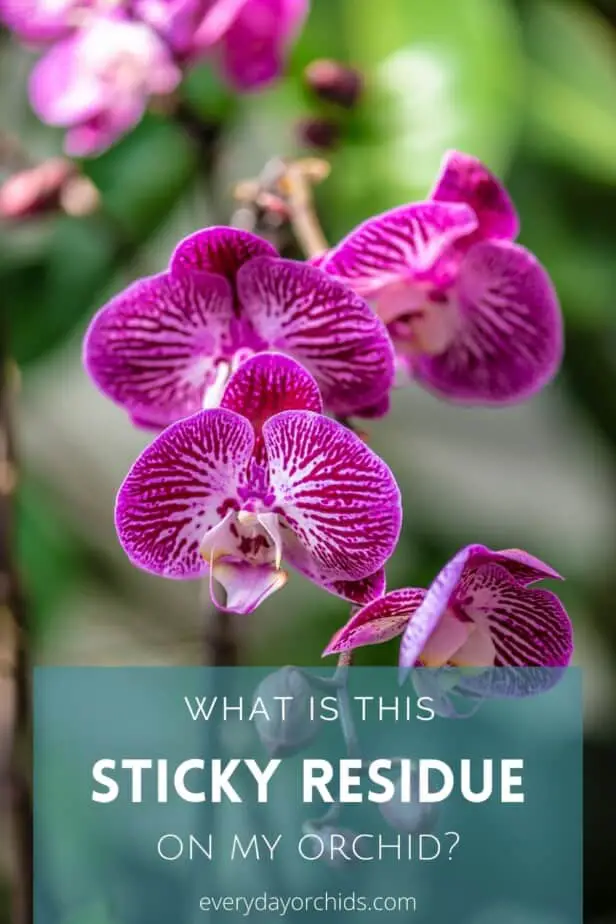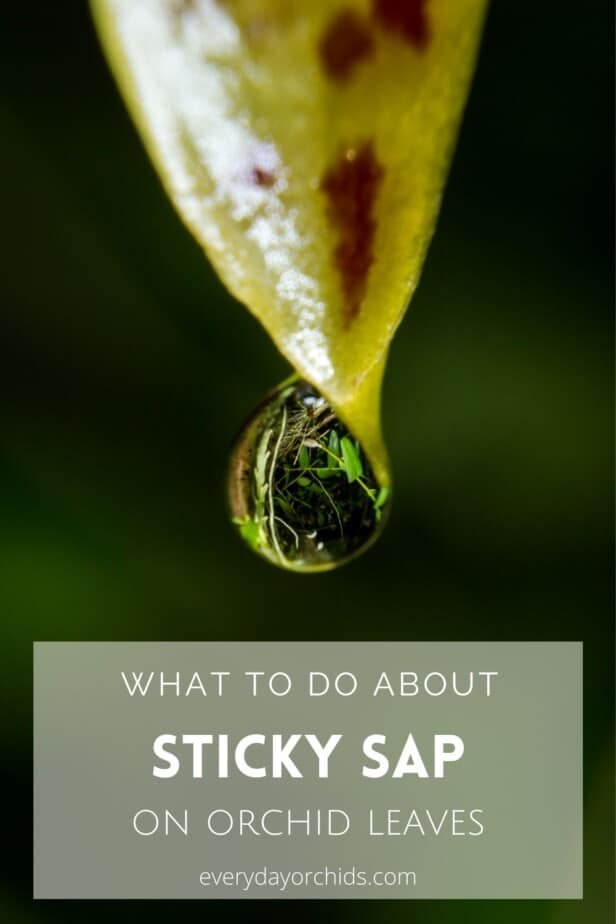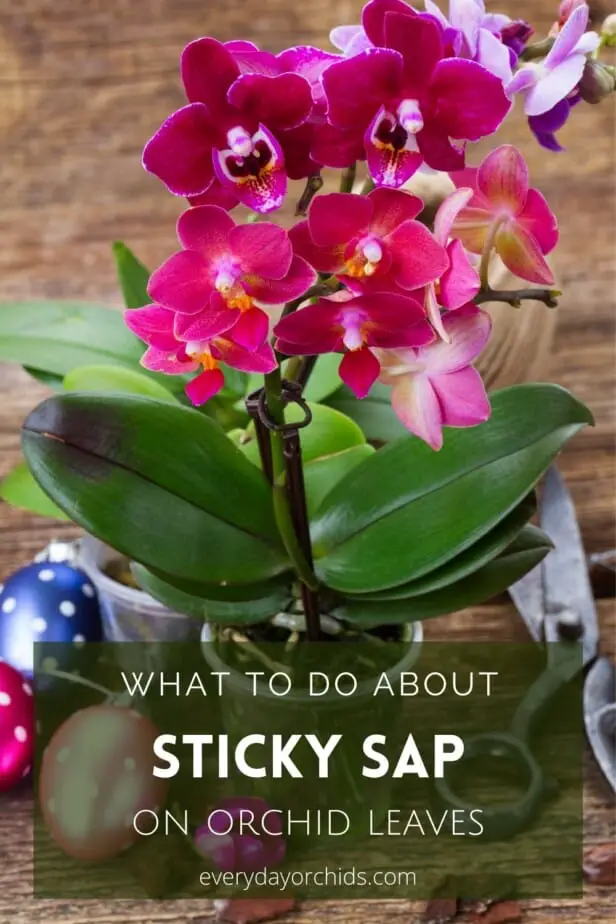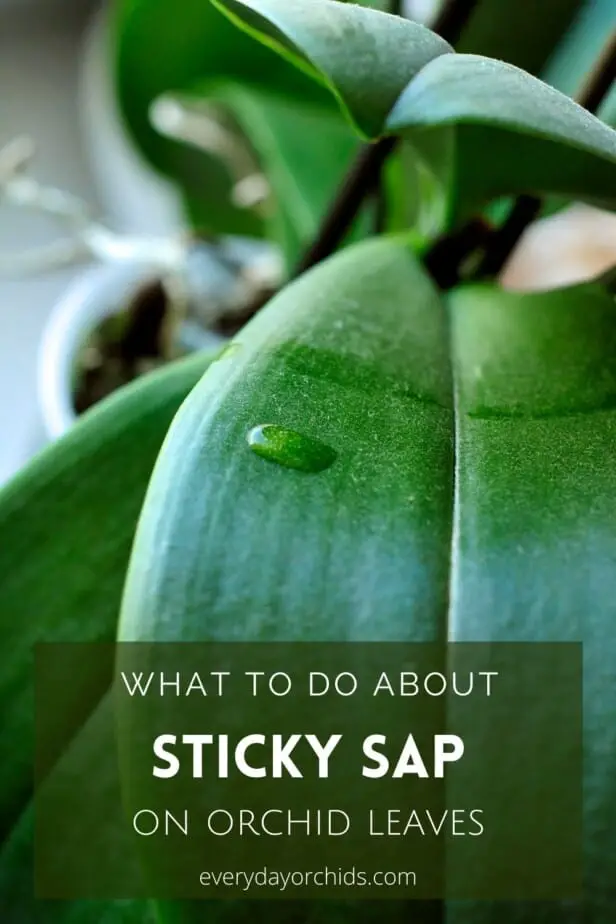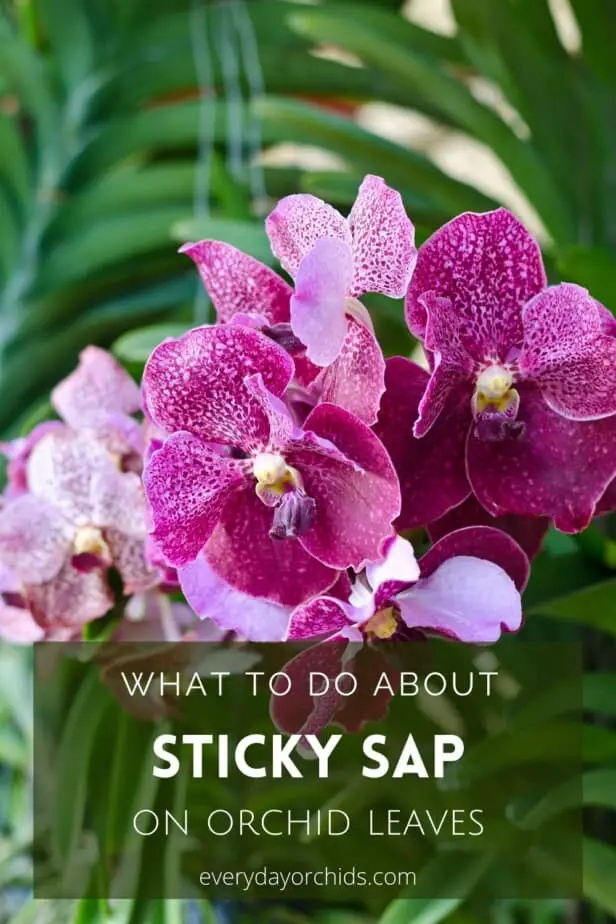Have you ever found a clear, sticky sap on your orchid leaves or orchid stem and wondered what it was? I have. At first, I thought that it was sap from the tree above my outdoor orchids.
But then, looking into it further, I found that there are actually many other reasons why you may find sticky sap on orchid leaves. Unfortunately, some of these reasons are indicative of a larger problem and need to be dealt with right away.
Clear sticky sap on an orchid stem or leaves can be the result of an aphid, mealybug or scale infestation. This sticky substance is a byproduct of these insects. If not dealt with, it can attract more insects, such as ants. Other times, sticky sap is produced by some orchids to attract pollinators. In this case, the clear sticky residue is totally normal but will still need to be cleaned off.
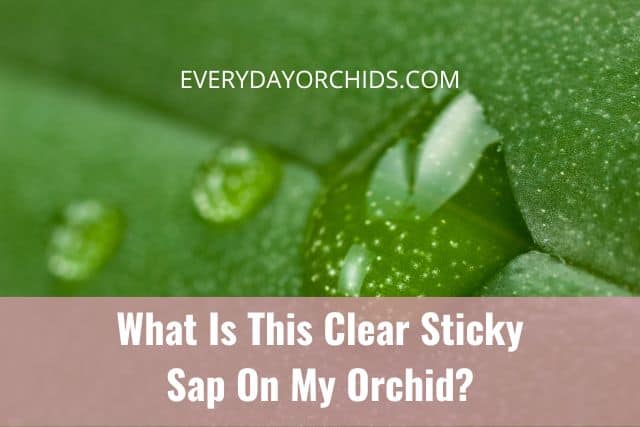
In this article, I’ll go over why your orchid may have sticky leaves and how to deal with the sticky sap. Keep reading to learn more about what causes sticky orchid leaves.
Please note that these links are affiliate links and as an Amazon Associate, I earn from qualifying purchases. Purchases made through affiliate links in this post may generate commissions at no additional cost to you. Use this link for a discounted Amazon Prime trial. Thank you for your support!
Table of Contents
Why Are My Orchid Leaves Sticky?

Some insects, such as aphids, mealybugs, and scale will excrete a sticky, clear sap called “honeydew.” This is found on the surfaces of plants wherever these insects are found. Usually by the time you notice this, an insect infestation is in full swing.
However, the presence of a sticky substance on orchid leaves does not always indicate an insect infestation. Some orchid species actually produce a sweet sticky sap to attract pollinators.
This normally happens in the wild, and many orchids still do this. If you have thoroughly searched your orchid for an orchid pest infestation and find none, there is a high chance that the sticky sap was made by your orchid. In this case, this is a natural byproduct of healthy orchid growth.
One key difference between the two causes of sticky sap will be the amount of sap found on the orchid. Large amounts of sticky sap likely indicate an insect infestation. Small amounts of sap, as in a few tiny drops here and there, are more likely made by the orchid itself.
I will go into more detail about both causes and what to do about them below.
What To Do With Honeydew Made By Insects
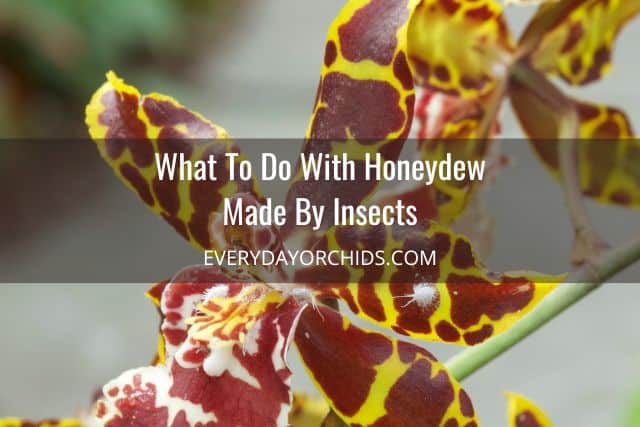
If you think that your sticky orchid leaves are due to insects, the first thing you should do is thoroughly inspect your orchid collection for aphids, scale, or mealybugs.
Look over all your orchids to make sure you identify all the orchids with insects. Chances are, if one orchid has a insect infestation, neighboring orchids will also have some level of infestation as well.
Check under the orchid leaves, in the crevices and joints between the leaves and stem, in the flower buds and flowers, and in the orchid crown. Insects are very good at hiding and you need to make sure you do a thorough inspection.
Once you’ve identified all the affected orchids, isolate them away from your other plants.
The presence of ants are usually a sign of a mealybug, scale or aphid infestation. Ants are attracted to the sticky honeydew substance excreted by other insects. These are smart creatures. Ants actually farm these other insects for the honeydew that they produce.
Ants are a late sign of an advanced insect infestation. If you see many ants around your orchid plants and pots, take note. This is not normal. It is a sign that something is going on with your orchid.
If left unaddressed, the sticky honeydew can lead to sooty mold, a fungal infection. What’s more, an insect infestation left untreated will eventually weaken and kill an orchid plant. Don’t let this happen to your orchid.
How To Get Rid Of Pests On Your Orchid
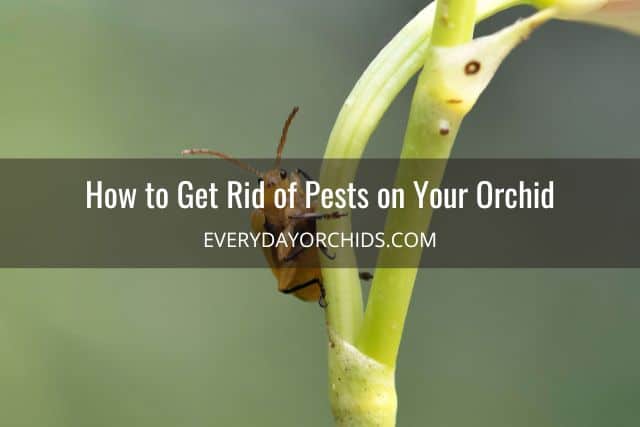
There are a few things you will need to do once you determine that the sticky orchid leaves are due to an insect infestation. First, you will need to identify the type of pest infesting your orchid. Methods for eliminating the actual bug will vary.
Here are some resources you can use for more information:
- How to Get Rid of Orchid Pests (info on how to get rid of aphids, scale, and mealybugs)
- How to Get Rid of Mealybugs (a more detailed guide)
- Top Problems Growing Orchids (includes info on aphids and scale)
- What to do if you find ants on your orchids (info on how to get rid of ants and keep them from coming back to your orchids)
Mealybugs
Mealybugs look like white fuzz or bits of cotton. They are often found in the crevices of orchids or under the leaves. These pests are best dealt with using 70% isopropyl alcohol (rubbing alcohol) and cotton swabs. Saturate each end of the cotton swab with rubbing alcohol and use this to remove the mealybugs.
The rubbing alcohol breaks through the mealybug’s protective outer coating and kills it on contact. Be sure to get all the mealybugs that may be hidden away in the cracks and crevices of the orchid. You may need to do this daily for several days until no more mealybugs are found.
Aphids
Aphids are pear-shaped, sap-sucking insects that can wreck havoc on orchids if left alone. They can usually be found underneath the orchid leaves or around the flower spikes and flower buds.
If you catch the infestation early on, you can manually remove these bugs with a cotton swab moistened with water.
For aphids showing up in larger numbers, you’ll want to use an insecticide such as Safer Soap. This product is organic and safe to use on orchids.
Spray this on your orchid every 7 to 10 days, focusing on the areas where you find aphids (or scale). As a bonus, Safer Soap is reported to be safe around children and pets.
Scale
Scale insects look like round, disc-like spots on your orchid. Look for small tan, black or brown bumps on the orchid leaves. If you wipe these bumps with a white paper towel and notice little specks come off, there is a good chance these are scale.
To get rid of these insects, prepare a mild soapy solution. Mix 1 teaspoon of dish detergent in 1 quart of warm water. Dip a clean, soft cloth into the soapy solution and wipe the scale off the leaves.
If you see scale in the crevices or hard to reach places of your orchid, use a cotton swab dipped in the soapy solution to get them. The soap suffocates and kills the scale.
Afterwards, be sure you clean the soapy residue off the orchid. Rinse the orchid leaves under gentle running water, then dry thoroughly.
For larger infestations, or if you have multiple orchids that are affected, you may want to use a horticultural or insecticidal spray to save time and effort.
Safer Soap, a natural organic insecticide, can be used on orchids. I mentioned above that you can use it to treat aphids, but actually, it can be used to treat scale and a wide variety of pests.
Neem Oil is a popular organic pest control solution. It is a 3-in-1 miticide, pesticide, and fungicide and kills bugs at all three stages of development (egg, larvae, adult). It is effective against scale, aphids and mealybugs, but you may need multiple applications to get all the bugs.
When applying Neem oil, follow the product instructions and spray in a well-ventilated area. Neem oil doesn’t smell the best, so just be sure you are aware of that before you spray down your orchid.
What To Do About Sticky Sap Produced By The Orchid
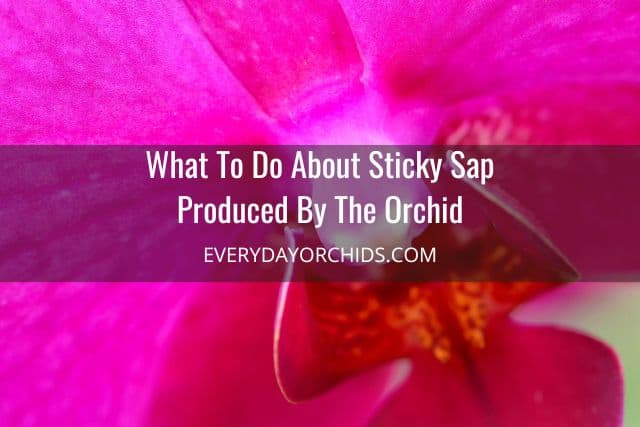
Check your orchid’s flowers to see if they are sticky. The orchid flowers themselves may be producing a clear sticky sap to attract pollinators. This is sometimes called “happy sap,” as it is a sign of a healthy, growing orchid.
Phalaenopsis orchids, Oncidiums and Cattleyas are a few orchids that can produce a sticky, clear residue. Some orchid species produce more “happy sap” than others. In those cases, the sticky sap can “overflow” from the orchid flowers and drip down to the orchid leaves or stem. You may also notice a clear sticky fluid oozing from the flower spike or stem.
Sometimes, you may see tiny, clear beads of sticky sap on the underside of orchid leaves. If there are no insects present, this is likely also “happy sap.” The orchid is pushing out excess sucrose through its leaves. This is also called “guttation.”
Can You Leave Sticky Sap On Your Orchid?
Unfortunately, no, you can’t leave the sticky substance on your orchid, whether it is on the leaves or on the stem. Even if this sap is from your orchid itself, it is important to remove it.
Sticky residue can lead to sooty mold, a fungal infection. Below, in the last section, is a picture of a leaf (not an orchid leaf) with sooty mold. As you can see, it looks dirty and the sticky sap has attracted dust, mold and who knows what else.
Sap can also attract ants and other sugar-loving insects to your orchid. If you didn’t have an insect infestation before, you may still end up with one if you don’t take steps to remove the sap.
What’s more, the sticky sap covering the orchid leaves will block the stomata from doing proper gas exchange. If the orchid is unable to get carbon dioxide for its basic functions, over time, it will start to show stunted growth.
How To Clean Sticky Orchid Leaves
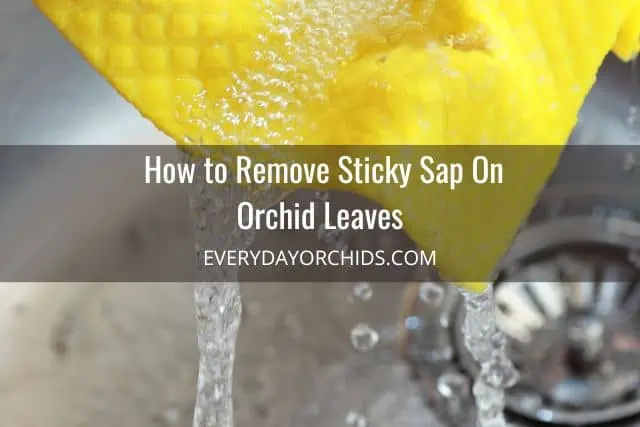
So, how do you clean sticky orchid leaves? It’s actually very easy. When you notice sticky sap on your orchid leaves, take a damp paper towel or soft cloth and gently wipe it off. Be sure you support the orchid leaf from the other side so that you don’t accidentally cause the leaf to crack or split.
If you use warm water to wet the cloth, this will help break down the sticky sap and make it easier to get off. Make sure you get all the sticky areas so that insects don’t end up coming to your orchid.
If you are having trouble getting the sticky substance to come off, you can try using a mild, soapy solution to get it off. Mix a few drops of a mild detergent (such as a mild dish soap) in a cup of warm water. Dip your paper towel of cloth in this soapy solution and gently rub the stubborn sticky sap off your orchid leaves or stem.
Then, be sure to wash off the soapy residue with water. Either hold the orchid leaf under gently running water, or use a clean wet cloth to wipe off the soap. Dry the orchid leaves afterward.
What If the Sticky Substance On Your Orchid Leaves Is Brown Or Black?
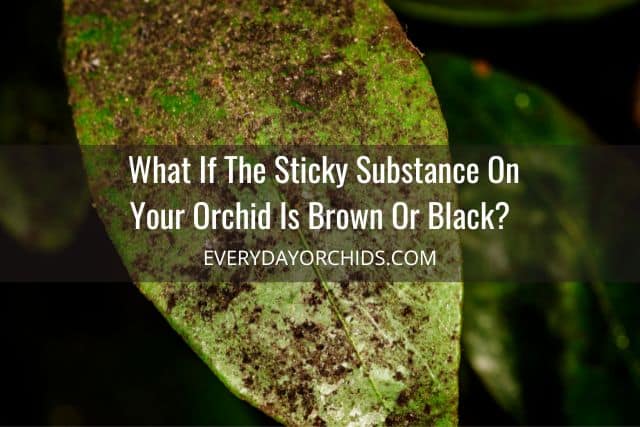
I’ve talked about what to do about clear sticky sap on an orchid, but there are times when you may come across a sticky area that is actually brown or black in color. If you see any brown or black sticky, wet areas on your orchid, take note! This is usually a sign of a bacterial or fungal infection.
If your orchid has dark brown or black sticky, wet areas on the stem or leaves, this is likely a sign of a bacterial infection.
If the orchid has sticky brown or black rings on the orchid leaves, this is likely due to a fungal infection.
The honeydew excreted by insects can lead to sooty mold. Sooty mold is a type of fungal infection that will only get worse if left untreated. This will form brown sticky, slimy areas on the orchid leaves. Given enough time, this will spread and cover the orchid leaves and lead to stunted growth and eventually, the orchid’s death.
In either case, whether the sticky dark areas on your orchid are caused by bacteria or fungus, you will want to deal with it immediately.
Removing Brown Or Black Sticky Infected Areas On Your Orchid
First, isolate your orchid away from your other plants. Inspect your orchid thoroughly. Also take some time to inspect your other orchids and plants to make sure that the infection has not already spread to them as well. Bacterial and fungal infections can spread quickly amongst plants that are in close proximity.
Cut off all infected areas using a pair of sterilized scissors or gardening shears.
Be sure to sterilize the scissors in between each cut to prevent further spreading the infection. I usually use a 10% bleach solution or rubbing alcohol to sterilize my gardening tools.
Throw the infected orchid parts in the trash and sterilize your scissors one last time before storing them away.
Place ground cinnamon powder on the cut ends of the orchid plant. This will seal it off and prevent further infection. Ground cinnamon powder is both a drying agent and an anti-fungal.
If your orchid’s brown or black sticky areas are due to a fungal infection, it has a higher chance of survival if the problem is treated early on. However, if it is due to a bacterial infection, there is a chance the orchid will not survive. Regular inspections of your orchids will help you catch these infections early on, giving your orchids a better chance at survival.
If you’d like to learn more, check out this article on how to treat mold and fungus on orchids.
Final Thoughts
In summary, if you find a clear, sticky substance on your orchid leaves, this may be an indicator of an orchid pest infestation or a healthy, happy growing orchid. You won’t be able to tell which one you have until you thoroughly inspect your orchid and search for bugs.
Aphids, mealybugs and scale are the three pests that can leave “honeydew” on your orchid leaves. Left untreated, this honeydew will attract fungus, creating sooty mold on your orchid’s leaves. Insecticides, Neem oil, and horticultural oils are ways you can deal with these pests.
Even if the sticky residue is a result of a healthy orchid simply excreting extra sucrose through its pores, you still will want to remove the sap. Sticky orchid leaves should be cleaned before pests or fungi take hold. Use warm water and a soft cloth to wipe your orchid leaves, orchid stem and flower spike clean.
Hope this helps! As always, happy orchid growing.
If you enjoyed this article, please pin it and share!
